文学翻译批评的理论框架
- 格式:pdf
- 大小:2.04 MB
- 文档页数:79
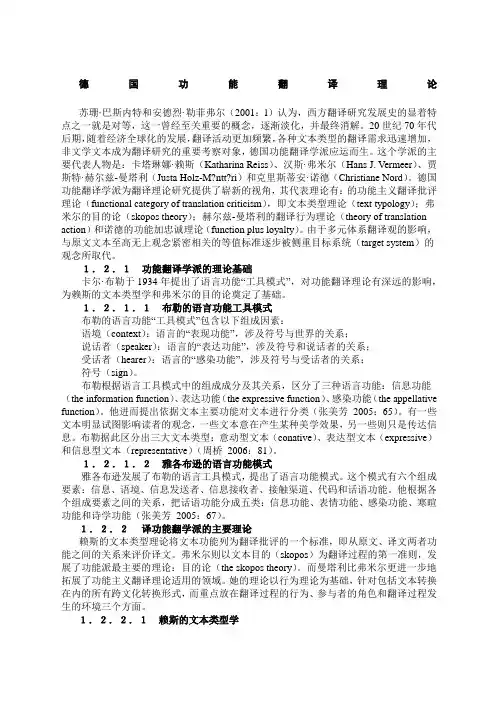
德国功能翻译理论苏珊·巴斯内特和安德烈·勒菲弗尔(2001:l)认为,西方翻译研究发展史的显着特点之一就是对等,这一曾经至关重要的概念,逐渐淡化,并最终消解。
20世纪70年代后期,随着经济全球化的发展,翻译活动更加频繁,各种文本类型的翻译需求迅速增加,非文学文本成为翻译研究的重要考察对象,德国功能翻译学派应运而生。
这个学派的主要代表人物是:卡塔琳娜·赖斯(Katharina Reiss)、汉斯·弗米尔(Hans J. Vermeer)、贾斯特·赫尔兹-曼塔利(Justa Holz-M?ntt?ri)和克里斯蒂安·诺德(Christiane Nord)。
德国功能翻译学派为翻译理论研究提供了崭新的视角,其代表理论有:的功能主义翻译批评理论(functional category of translation criticism),即文本类型理论(text typology);弗米尔的目的论(skopos theory);赫尔兹-曼塔利的翻译行为理论(theory of translation action)和诺德的功能加忠诚理论(function plus loyalty)。
由于多元体系翻译观的影响,与原文文本至高无上观念紧密相关的等值标准逐步被侧重目标系统(target system)的观念所取代。
1.2.1功能翻译学派的理论基础卡尔·布勒于1934年提出了语言功能“工具模式”,对功能翻译理论有深远的影响,为赖斯的文本类型学和弗米尔的目的论奠定了基础。
1.2.1.1布勒的语言功能工具模式布勒的语言功能“工具模式”包含以下组成因素:语境(context):语言的“表现功能”,涉及符号与世界的关系;说话者(speaker):语言的“表达功能”,涉及符号和说话者的关系;受话者(hearer):语言的“感染功能”,涉及符号与受话者的关系;符号(sign)。
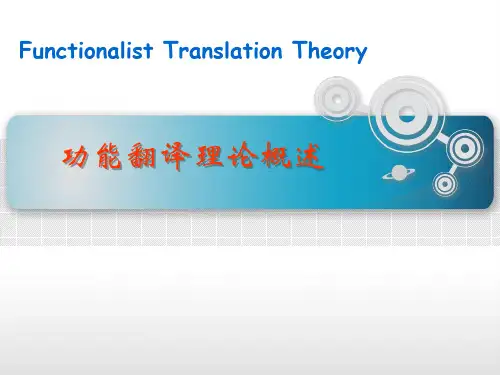
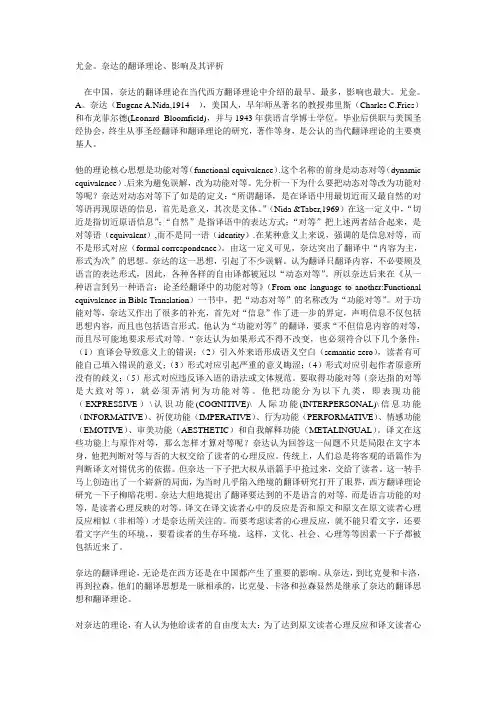
尤金。
奈达的翻译理论、影响及其评析在中国,奈达的翻译理论在当代西方翻译理论中介绍的最早、最多,影响也最大。
尤金。
A。
奈达(Eugene A.Nida,1914---),美国人,早年师丛著名的教授弗里斯(Charles C.Fries)和布龙菲尔德(Leonard Bloomfield),并与1943年获语言学博士学位。
毕业后供职与美国圣经协会,终生从事圣经翻译和翻译理论的研究,著作等身,是公认的当代翻译理论的主要奠基人。
他的理论核心思想是功能对等(functional equivalence).这个名称的前身是动态对等(dynamic equivalence).后来为避免误解,改为功能对等。
先分析一下为什么要把动态对等改为功能对等呢?奈达对动态对等下了如是的定义:“所谓翻译,是在译语中用最切近而又最自然的对等语再现原语的信息,首先是意义,其次是文体。
”(Nida &Taber,1969)在这一定义中,“切近是指切近原语信息”;“自然”是指译语中的表达方式;“对等”把上述两者结合起来,是对等语(equivalent),而不是同一语(identity).在某种意义上来说,强调的是信息对等,而不是形式对应(formal correspondence)。
由这一定义可见,奈达突出了翻译中“内容为主,形式为次”的思想。
奈达的这一思想,引起了不少误解。
认为翻译只翻译内容,不必要顾及语言的表达形式,因此,各种各样的自由译都被冠以“动态对等”。
所以奈达后来在《从一种语言到另一种语言:论圣经翻译中的功能对等》(From one language to another:Functional equivalence in Bible Translation)一书中,把“动态对等”的名称改为“功能对等”。
对于功能对等,奈达又作出了很多的补充,首先对“信息”作了进一步的界定,声明信息不仅包括思想内容,而且也包括语言形式。
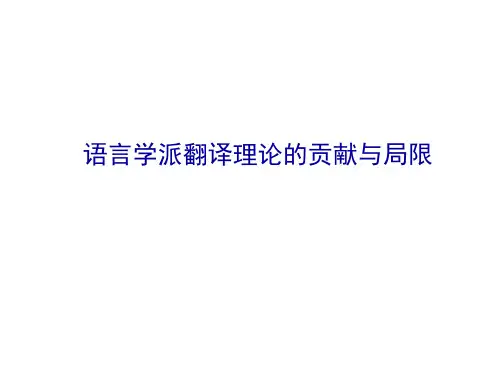
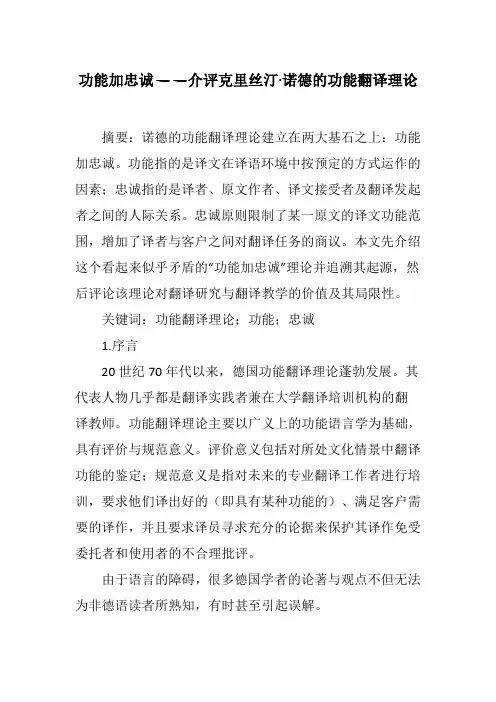
功能加忠诚——介评克里丝汀·诺德的功能翻译理论摘要:诺德的功能翻译理论建立在两大基石之上:功能加忠诚。
功能指的是译文在译语环境中按预定的方式运作的因素;忠诚指的是译者、原文作者、译文接受者及翻译发起者之间的人际关系。
忠诚原则限制了某一原文的译文功能范围,增加了译者与客户之间对翻译任务的商议。
本文先介绍这个看起来似乎矛盾的“功能加忠诚”理论并追溯其起源,然后评论该理论对翻译研究与翻译教学的价值及其局限性。
关键词:功能翻译理论;功能;忠诚1.序言20世纪70年代以来,德国功能翻译理论蓬勃发展。
其代表人物几乎都是翻译实践者兼在大学翻译培训机构的翻译教师。
功能翻译理论主要以广义上的功能语言学为基础,具有评价与规范意义。
评价意义包括对所处文化情景中翻译功能的鉴定;规范意义是指对未来的专业翻译工作者进行培训,要求他们译出好的(即具有某种功能的)、满足客户需要的译作,并且要求译员寻求充分的论据来保护其译作免受委托者和使用者的不合理批评。
由于语言的障碍,很多德国学者的论著与观点不但无法为非德语读者所熟知,有时甚至引起误解。
诺德(Christiane Nord)是德国翻译研究克里丝汀界的领袖人物,她意识到语言在学术交流中的重要性,于是将其德语著作《翻译中的语篇分析:理论、方法及翻译导向的语篇分析模式在教学中的应用》翻译成英语出版,此书在翻译界引起了很大的反响,之后她再接再励,直接用英语著书,《翻译是一种目的性活动解释功能翻译理论》于1997年问世。
该书全面介绍了德国功能翻译学派的理论,解释这些理论的模糊点及其术语,同时也阐明她本人的功能翻译观点。
诺德深受其老师莱思的文本类型学的影响,十分忠诚于弗米尔的目的论,非常赞赏霍斯-曼特瑞的翻译行为理论;同时也有自己的见解。
她把忠诚原则引入功能主义模式,希望解决翻译中的激进功能主义问题。
忠诚指的是译者、原文作者、译文接受者及翻译发起者之间的人际关系。
诺德宣称,功能主义理论可以涵盖翻译的所有类型,而且对翻译教学有特别重要的意义。

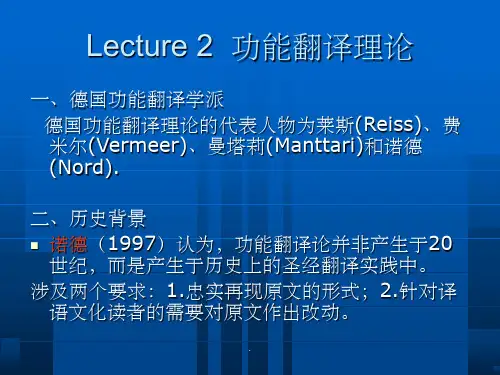
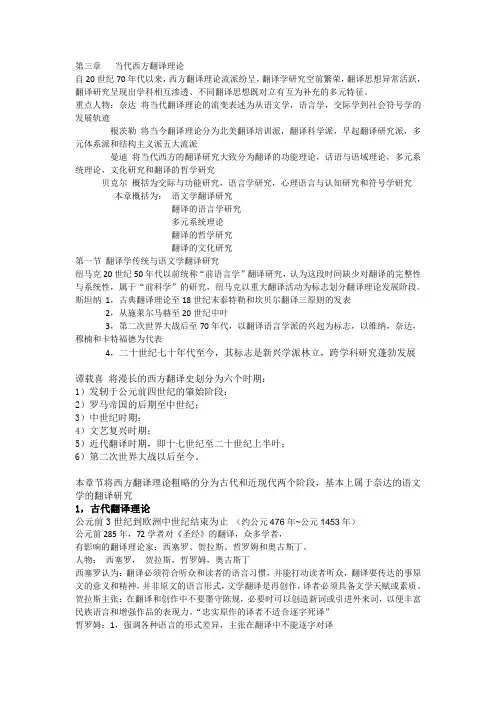
第三章当代西方翻译理论自20世纪70年代以来,西方翻译理论流派纷呈,翻译学研究空前繁荣,翻译思想异常活跃,翻译研究呈现出学科相互渗透、不同翻译思想既对立有互为补充的多元特征。
重点人物:奈达将当代翻译理论的流变表述为从语文学,语言学,交际学到社会符号学的发展轨迹根茨勒将当今翻译理论分为北美翻译培训派,翻译科学派,早起翻译研究派,多元体系派和结构主义派五大流派曼迪将当代西方的翻译研究大致分为翻译的功能理论,话语与语域理论,多元系统理论,文化研究和翻译的哲学研究贝克尔概括为交际与功能研究,语言学研究,心理语言与认知研究和符号学研究本章概括为:语文学翻译研究翻译的语言学研究多元系统理论翻译的哲学研究翻译的文化研究第一节翻译学传统与语文学翻译研究纽马克20世纪50年代以前统称“前语言学”翻译研究,认为这段时间缺少对翻译的完整性与系统性,属于“前科学”的研究,纽马克以重大翻译活动为标志划分翻译理论发展阶段。
斯坦纳1,古典翻译理论至18世纪末泰特勒和坎贝尔翻译三原则的发表2,从施莱尔马赫至20世纪中叶3,第二次世界大战后至70年代,以翻译语言学派的兴起为标志,以维纳,奈达,穆楠和卡特福德为代表4,二十世纪七十年代至今,其标志是新兴学派林立,跨学科研究蓬勃发展谭载喜将漫长的西方翻译史划分为六个时期:1)发轫于公元前四世纪的肇始阶段;2)罗马帝国的后期至中世纪;3)中世纪时期;4)文艺复兴时期;5)近代翻译时期,即十七世纪至二十世纪上半叶;6)第二次世界大战以后至今。
本章节将西方翻译理论粗略的分为古代和近现代两个阶段,基本上属于奈达的语文学的翻译研究1,古代翻译理论公元前3世纪到欧洲中世纪结束为止(约公元476年~公元1453年)公元前285年,72学者对《圣经》的翻译,众多学者,有影响的翻译理论家:西塞罗、贺拉斯、哲罗姆和奥古斯丁。
人物:西塞罗,贺拉斯,哲罗姆,奥古斯丁西塞罗认为:翻译必须符合听众和读者的语言习惯,并能打动读者听众,翻译要传达的事原文的意义和精神,并非原文的语言形式,文学翻译是再创作,译者必须具备文学天赋或素质。
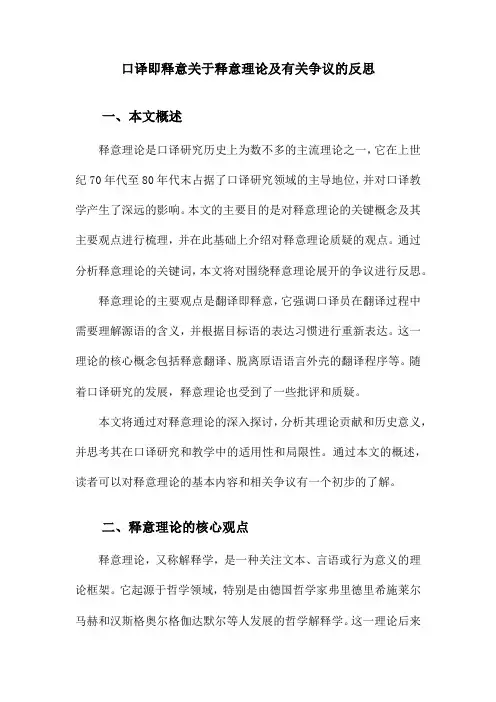
口译即释意关于释意理论及有关争议的反思一、本文概述释意理论是口译研究历史上为数不多的主流理论之一,它在上世纪70年代至80年代末占据了口译研究领域的主导地位,并对口译教学产生了深远的影响。
本文的主要目的是对释意理论的关键概念及其主要观点进行梳理,并在此基础上介绍对释意理论质疑的观点。
通过分析释意理论的关键词,本文将对围绕释意理论展开的争议进行反思。
释意理论的主要观点是翻译即释意,它强调口译员在翻译过程中需要理解源语的含义,并根据目标语的表达习惯进行重新表达。
这一理论的核心概念包括释意翻译、脱离原语语言外壳的翻译程序等。
随着口译研究的发展,释意理论也受到了一些批评和质疑。
本文将通过对释意理论的深入探讨,分析其理论贡献和历史意义,并思考其在口译研究和教学中的适用性和局限性。
通过本文的概述,读者可以对释意理论的基本内容和相关争议有一个初步的了解。
二、释意理论的核心观点释意理论,又称解释学,是一种关注文本、言语或行为意义的理论框架。
它起源于哲学领域,特别是由德国哲学家弗里德里希施莱尔马赫和汉斯格奥尔格伽达默尔等人发展的哲学解释学。
这一理论后来被应用于多个领域,包括文学研究、法律、心理学和口译等。
文本的多重意义:释意理论认为,文本不是静态的、单一意义的实体,而是具有多重潜在意义的动态结构。
每个读者或听者都会根据自己的背景知识和经验,对文本进行独特的解读。
读者的角色:在释意过程中,读者或听者扮演着至关重要的角色。
他们的预期、先入为主的观念和文化背景都会影响对文本的理解。
理解文本是一个主观的过程,每个个体的解释都是独一无二的。
历史和文化背景:释意理论强调历史和文化背景在理解过程中的重要性。
文本是在特定的历史和文化背景下产生的,理解文本需要对这些背景有所了解。
解释的循环:理解是一个循环往复的过程,称为“解释的循环”或“理解的循环”。
这意味着在理解一个文本时,我们不断地在整体和部分之间移动,从整体中理解部分,再从部分中理解整体。
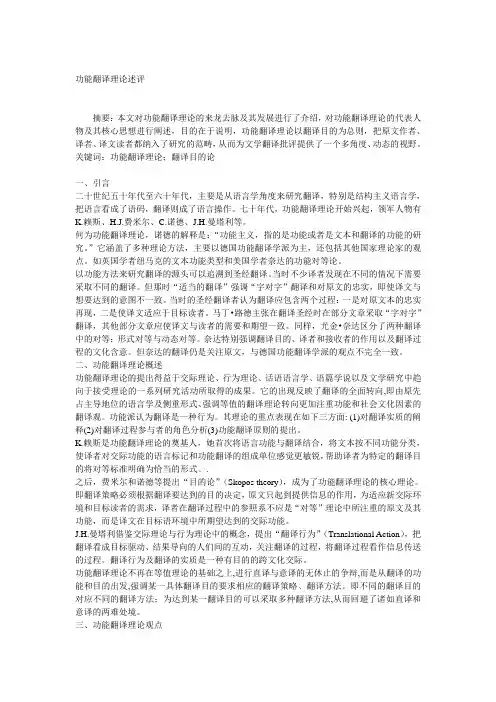
功能翻译理论述评摘要:本文对功能翻译理论的来龙去脉及其发展进行了介绍,对功能翻译理论的代表人物及其核心思想进行阐述,目的在于说明,功能翻译理论以翻译目的为总则,把原文作者、译者、译文读者都纳入了研究的范畴,从而为文学翻译批评提供了一个多角度、动态的视野。
关键词:功能翻译理论;翻译目的论一、引言二十世纪五十年代至六十年代,主要是从语言学角度来研究翻译,特别是结构主义语言学,把语言看成了语码,翻译则成了语言操作。
七十年代,功能翻译理论开始兴起,领军人物有K.赖斯、H.J.费米尔、C.诺德、J.H.曼塔利等。
何为功能翻译理论,诺德的解释是:“功能主义,指的是功能或者是文本和翻译的功能的研究。
”它涵盖了多种理论方法,主要以德国功能翻译学派为主,还包括其他国家理论家的观点。
如英国学者纽马克的文本功能类型和美国学者奈达的功能对等论。
以功能方法来研究翻译的源头可以追溯到圣经翻译。
当时不少译者发现在不同的情况下需要采取不同的翻译。
但那时“适当的翻译”强调“字对字”翻译和对原文的忠实,即使译文与想要达到的意图不一致。
当时的圣经翻译者认为翻译应包含两个过程:一是对原文本的忠实再现,二是使译文适应于目标读者。
马丁•路德主张在翻译圣经时在部分文章采取“字对字”翻译,其他部分文章应使译文与读者的需要和期望一致。
同样,尤金•奈达区分了两种翻译中的对等:形式对等与动态对等。
奈达特别强调翻译目的、译者和接收者的作用以及翻译过程的文化含意。
但奈达的翻译仍是关注原文,与德国功能翻译学派的观点不完全一致。
二、功能翻译理论概述功能翻译理论的提出得益于交际理论、行为理论、话语语言学、语篇学说以及文学研究中趋向于接受理论的一系列研究活动所取得的成果。
它的出现反映了翻译的全面转向,即由原先占主导地位的语言学及侧重形式、强调等值的翻译理论转向更加注重功能和社会文化因素的翻译观。
功能派认为翻译是一种行为。
其理论的重点表现在如下三方面: (1)对翻译实质的阐释(2)对翻译过程参与者的角色分析(3)功能翻译原则的提出。

翻译文化学派代表人物及其理论-精选资料翻译文化学派代表人物及其理论西方翻译理论研究发展至今,在其理论研究不断完善细化的同时也出现了几大转向,概括起来可分为以下几类:从规定性研究转向描述性研究,关注焦点从文本转向文本上下文,从作者转向读者,从原文本转向译文本,从文本的语言学层面转向文本的社会文化层面。
在此大背景下,翻译的文化学派及其理论在西方学界越来越受到重视并逐渐成为西方翻译研究的主流。
笼统地讲,文化学派在研究翻译时更关注翻译文本,翻译过程,翻译策略等所受到的外部文化社会的操控和影响。
本文将对文化学派几位代表人物及其主要理论思想进行梳理性介绍。
詹姆斯?霍尔姆斯詹姆斯?霍尔姆斯被认为是翻译研究学派的创始人,翻译文化学派的主要人物之一,他的主要贡献在于翻译学科建设方面。
当人们还在争论翻译是否该被视为一门独立的学科时霍尔姆斯就在其《翻译学的名与实》(The Name and Nature of Translation Studies)一文里提出了关于翻译学学科建设的构想,该文章也被普遍认为是翻译学科建设的奠基之作。
[1]在文章中他探讨并阐述了诸如翻译学学科的命名,研究范围和划分等一系列学科基本问题,并提出了著名的翻译学的学科框架图。
塔玛?埃文-佐哈尔以色列学者佐哈尔从观察翻译对社会的影响的角度于1979年首次提出多元系统(Polysystem Theory),他本人也被视为“翻译研究学派”的先驱之一。
他认为,文化、语言文学、社会都不是由互不相干的元素组成的混合体,而是由相关的元素组成的系统。
这些系统,又不是单一的系统,而是由多个相交甚至相迭的系统组成。
在这种认识的基础上,他创造了“多元系统”这个理论术语。
所谓的“多元系统”,指的是社会中各种相关的系统――文学以及文学以外所有相关的系统的集成,用以解释该文化中全部的书写; 佐哈尔在阐述多元系统理论时,着重讨论了翻译作为多元系统中的一个系统在文学多元系统里所占的位置。
美国翻译培训派(The American Translation Workshop)注重文学作品的翻译,其指导思想是翻译是一门艺术,培训班可以加强学生对文学、语言和诠释的认识和理解,进而通过翻译经验的交流提高翻译技艺和水平.里查兹、庞德和威尔是该学派的主要代表.里查兹(I. A. Richards)曾在哈佛大学创办阅读培训班,为翻译培训班提供了丰富的实践经验。
翻译培训班的宗旨是要使学生充分理解文本,达成正确而统一的反映和体验,并用完美的口、笔译形式再现或阐述这一体验。
其理论前提显然是文学作品有一个终极的、统一的意义。
只要通过适当的训练,掌握正确的方法,人们就能准确地理解原文。
翻译培训班的任务就是制定若干条款和程序,排除一切妨碍正确理解的障碍。
庞德(Ezra Pound)认为文学作品刻意塑造的是形象,而非内容或意义。
在翻译中译者应注重的不是所描写的事物,而是描述的过程和语言的形式与能量(energy)。
译者如同艺术家、雕刻家和书法家,应精确地再现细节、词语、片段和整个意象.作品真正的灵魂常常蕴藏于“一瞥或一瞬之间”。
威尔(Frederic Will)认为文学作品是表现自我、统一而连贯的形式,能赋予我们洞悉事物本质的能力。
语际交际和翻译之所以可能,是因为人类的体验和情感有一个共核。
在翻译中他强调直觉的作用,认为在诗歌翻译中,有天赋的翻译家即使不精通原作的语言也同样可以再现原作的精髓与本质.他认为,所谓精髓和本质就是作品的能量和冲量(thrust),译文不仅是原作的补充和延伸,而且使原作获得新的生命,勃发出新的生机。
美国翻译培训派对人类主观无意识的研究、强调文学翻译中的“创造性转换(creative transposition)”、注重文学作品的文学价值以及在译文忠实的标准问题上提出的新颖观点等,都对其后的翻译学派产生了巨大影响。
翻译科学派(The Science of Translation)亦称翻译语言学派,包括布拉格学派、伦敦学派、美国结构学派、交际理论派和俄国语言学派。
中国翻译理论史中国翻译理论发展脉络关于理论理论与应用的关系:传统观点,不解决实际问题的理论是无用的。
是理论就一定要解决实际问题。
申报基础理论项目一定要回答“该项目有什么实际应用价值”的问题。
现代观点: 理论“虚用”说。
“理论实用”论使得许多有前途的基础理论研究搁浅。
翻译界同行拿不出与国外同行挑战的实力的理论来,就是因为在很大程度上被理论实用论禁锢,他们认为是理论就要解决实际问题,所以目前不解决实际问题的重大理论总是出不来。
中的翻译理论从总体上看是注重“实用”的,是解决翻译具体问题的,与西方当代翻译理论相比,在体系上相对较弱。
能解决实际问题的而理论当然应该受到鼓励,但对理论的要求不应该以是否有实用价值为前提。
在科学史上,有些重大理论在一开始并不表现出实用性,后来才引起大规模的应用。
爱因斯坦的相对论最初问世时人们看不到它的实用价值,在部分理论得到应用后,甚至在新的理论出现后(霍金),其余部分的实用价值还未显现,但他改变了我们的思维方式。
成熟的理论总是在等待着实用出现的契机,或者它引导出一种是用契机。
我们不能因等不到这种契机就指责这种理论无用。
许多翻译工作者不愿阅读翻译理论文章,因为他们发现这些理论不能帮助解决实际问题。
只有当有外在要求时才勉强看一些理论,比如职称要求。
翻译工作者要有理论意识。
人们主动认识规律的倾向就是理论意识。
又有些理论可能永远找不到实用契机。
这种空头理论具有不显形的性质,但能使我们学会思考,是我们的素质得到根本的提高。
不能转化为现实生产力的理论也是理论。
对理论的首要要求应是该理论能不能逻辑的认识和解释对象。
能不能在别的方面派上用场,那不是它们的事。
“用”有“实用”也可有“虚用”。
翻译理论既鼓励“实用”也鼓励“虚用”,实用理论的威力自不待言,虚用理论可提高我们的认识能力,可以放飞我们的心智,使其抵达极限之极限。
关于翻译理论翻译学本身就是一套完整的理论体系,它由一系列的相互联系的概念构成。
功能翻译理论及其在文学翻译中的应用1 引言传统翻译理论把“对等”看作衡量译文质量的最可靠标准。
然而, 20世纪70年代,功能翻译理论开始兴起,,其代表人物是凯瑟林娜·莱斯(Katharina Reiss) 、汉斯·弗米尔(Hans Ver2meer)和克里斯蒂安·诺德(Christiane Nord) 。
何为功能翻译理论,诺德的解释是:“功能主义,指的是功能或者是文本和翻译的功能的研究。
”它涵盖了多种理论方法,主要以德国功能翻译学派为主,还包括其他国家理论家的观点。
功能翻译理论给人们提供一个探讨翻译的新视角,实现了翻译理论从静态的语言翻译象征论向动态的功能翻译分析法的转化。
那么功能翻译理论的主要内容有那些呢,它能否应用到文学的翻译中去呢?2 功能翻译理论的主要内容莱斯、费米尔和诺德等提出的功能翻译理论认为,翻译不仅是人类一种有目的性的行为,是一项须要考虑读者和客户要求的目的性交际行为。
的确,翻译需要译者与原本之间的交流。
由于语言种类、文化背景、思维方式、表达习惯上的差异,原语作者的意图和采用的语篇形式与译文读者的接受能力存在着一定差异。
因此,译者在翻译过程中有必要从译语读者角度出发,根据译文的预期目的决定自己的翻译策略与方法。
功能翻译理论最核心的概念是翻译目的论( skopos theory) 与翻译行为理论( the theory of translational action) 。
2. 1 目的论费米尔在他的《普通翻译理论框架》一书中提出了“目的”这个概念。
目的论中除了术语“目的”(Skopos)之外,费米尔还使用了与之其他有关联的词,比如目标(aim)、目的(purpose)、意图(intention)和功能(function)。
目标(aim)指的是翻译行为最终达到的结果。
目的(purpose)指达到目标过程中的阶段。
意图(intention)是目标导向的翻译行为,既包括发送者以适当的方式产生文本,也包括接受者以适当的方式理解译文。
文学翻译批评的理论框架摘要\本文是对文学翻译批评的一种界定性研究,旨在卉清文学翻译批评究竟是什么这一雕沦¨题。
叟学翻译足翻译的重要组成}}Ij分,文学翻译的研究具有重大理论价值。
然iflJ,^‘种较为普遍的脱象足人们往往把翻译研究默认为文学翻译研究,从】『ii混淆了翻译研究与文学翻译研究的K别。
I刊样,在文学翻泽批评领域,池存在类似的iI口J题,即人们倾向f把翻泽-JLL.I,'Iz默认为文学翻泽JLL4.。
i£o此外,文学翻泽批评的丛础理论研究,1i够,比如,文学翮泽批评究竟足4t么。
存基础_li论研究0i充分的情况下研究其他问题,jwE沦价值难免受到影响。
、l,l然,…r翻泽批评也括文学翻汗批评,还山j二订螳学肯研究的剐湃j11:i.Ii实酗:上班圮怂义。
产黜浑批计,凼Ifu他们射翻译批计的研究刈本文研究文学翻译-l!:t7'1:仍有指导意义。
虽然彳f些资料对文学翻译批评的研究不够全面,但是把这些资料综合翱;起来面,它们仍刘‘文学翻译批评的研究具有理论价值,从,1i同力‘面揭/J÷了文学翻译批评的性质。
I-10口所收集到的资制表nJJ,i2,仃研究人多集t}uI在罨封译批pFfl9内部系统这一方面。
畅晓荣,I:恩琵,郏海凌,PeterNewmark,Bemoan等对翻译批评’r}:质,类型,功能,标准,方法等的研究,初步构建出翻译批计的基本理论框架。
明:钧的《文学翻洚.ILLi.'I'-I,Tf',D)。
fS作为H内较‘,tfl',j以“文学翻译jILLl.,'1…’冠名f14j.nlt沧著作,体现.广训『究的准确,rL,对该领域的研究起J’示范作用。
他在。
Ⅲ},探讨了文学番4j译jLLi4"fl;J一些艇本问题.,f结合实践进行了批评。
在外部系统方曲,个【[1i而理论性较强的研究还不够。
4;过,有些学者x·tili4=l译jLLLtz在翻译教学cp运用的研究,如马红军的《翻i晕JLLkti散论》,赵桂华的《翻溽理沦‘j技巧》,为本文研究文学翻i罩-Jl:l:i.'lz与lU关理论的关系作了理沦准备。
本文是在}{i『人fl',j基础上进行的深入研究。
1功一本文首先}刿确提It{文学翻译批评这一概念,}uI;imii本文研究的是文学翻译批评l『【『1:足翻译批评;努力避免概念/1:清,避免J1]t,tli}-:tLL].'tj指代文学翻译批评;Jl刈文学制洋批评系统tlr的准术妣念(如文学翻i荦.iLLi:Ii『}0定义)进{j尽刈1能严格的界定:对易H皑淆的概念t如力法1』牛,J硎:)进仃特5}1J【爱分。
/:、征内部系统r|1(第3章),本文深入州究了义学翻泽批评的性质,类,弘,功能,标准__fll,J法,卡JJ步构建了文学翻译批评的理论框架,行尝试着回答了文学翻译批评是什么,如何进行文学翻译批评等胖沦iluJ题。
本文还特别提出了几义学翻译批盯的概念,{}{…剥文学翻i幂}llfi:l。
本身的}ltkt'-f‘分重要,有助1i文学翻泽批评的理沦建设。
证外部系统rI·(第4章).本义硼f究r文学翻泽批评与文学翻译教学的关系,文学翻译批评与文学翻湃技巧的区别,以及史学翻译批评与文学翻译理论的关系,从腼确定了文学翻译批评征文学翻洋理沦系统rfI的位筲,有助丁我们史为准确地把握文学翻译批评的性胍等理沦问题。
虮J:所述玎幂j:亡,{‘先址舀!内部系统。
IJ把文学酬i棼批评分解成性质,类型,J』J能,标准,方法等要素进行微舭研究;然后义在外部系统中把文学翻t季-}LL评作为一个祭体,宏观研究le与1fj关理沦的关系。
通过对文学罨封泽批评在内部系统f|J进行解牛』i研究以及尢外部系统tfJ进行比较研究,使我们刘文学翻译批评性质的理解更JJ【|深刻准确。
文学翻ie::『LL评的理沦框架足动态的,不是静念的。
它随着文学翻译理沦与川天理沦的发展I而不断变化,凶而需要我们运用新理论不断深化刘其认U{。
此外,我们还需要强化文学翻洋批评的丛础理论"f究,吲为越是基础的理论越往往具有重要价值,越能刈术来的研究产生影响。
关键词:文学翻译批评;内部系统;外部系统ATheoreticalFrameworkofLiteraryTranslationCriticismAbstractThisdissertationisadefinhlgattemptatliterarytranslationcriticism,aimingtoexplorethetheoreticalquestionofwhatisliterar),translationc,‘iticism.Literarytranslation,theresearchintowhichisoftheoreticalsignificance,countsasanimportantpartoftranslation.However.peopletendtoconsidertranslationstudiesasliterarytranslationstudies,thusblurringthediffercnccbetweenthcnl.Sodoesthefieldel、literarytranslationcriticismPeopletendtoconsidertranslationcriticismasliterarytranslationcriticisnl.Moreover,tileresearchintobasictheoriesisnotdeepenoughWithoutafinnlbundationinbasictheories,tileresearchintootheraspcctsoflitm‘arytranslationcriticismisusuallysuperficial.Becausetranslationcriticisnlismoregeneralacategorythanliterarytranslationcriticism,andbecausewhatpeopleactuallystudyisliterarytranslationcriticism,theirresearchesOlltranslationcriticismarestillofhelptothisdissertation.Althoughthosestudiesofliterarytranslationcriticismareuotcomprehensiveenoughifseeninisolation,theyexploreahnosteveryaspectoflitct‘arytranslationcriticismirtakenasawhole.Astotheinnersystem,YangXiaorong,WangEnmian,ZhengHailing,PeterNewmark,Bcrnlanandmanyotherscholarsresearchonnature,typology,function,criterionandmethodology.Litera0,TranslationCriticismResearchbyXuJuuisonooftheearliestmonographsentitledwith‘literarytranslationcriticism’inChina,reflectingtheaccuracyel‘studyAstotheoutersystem.therea1.efewsystematicresearches.However,sonleworksontheapplicationoftranslationcriticismintranslationteaching,say,Random矗』,缸011Transhaion0‘iticismbyMaHongjun,7)4arts/alienTheoryandTechniquebyZhaoGuihua,plovidcatheoreticalbasisforthisdissertationThisdissertationisafurtherresearchbascduponpreviousliteratureonthissubject.Itputsforwarddefinitelytheconceptofliterarytranslationcriticism,pointingoutwhatthisdissertationconcentratesuponisliterarytranslationcriticism,butnottranslationcriticism.Itdefinesthebasicconcepts(tilenature,methodology,ctc.)ofliterarytranslationcriticismasstrictlyaspossibletoavoidambiguities,andmakesspecialdistinctionsbctweenconfusingconcepts,likeliterarytranslationcriticismversusliterarytranslationteclmique.Tiffsdissertationfirststudiesliterarytranslationcriticisminitsinnersystem(Chapter3),exalniningnature,typology,function,criterionandmethodology,constructingaprelinlinaryframeworkofliterarytranslationcriticismandtryingtoanswerquestionssuchaswhatisliteratytranslationcriticism,howlocoml,wtit.Thisdissertationspeciliestheconceptofrecta-literarytranslationcriticisminparticular,notingthatthecriticismofliterarytranslationel‘iticismassuchisofgreatsignificancemidthatitcontributestOthcoreticalstudies.Thenthisdissertationstudiesliterarytranslationcriticisminitsoutersystem(Chapter4),examiningtilerelationshipbetweenliterarytranslationcriticismanditsrelateddisciplines,thatis,literarytranslationteaching,literarytranslationtechniqueandliterarytranslationtheory,enablingUStolocatethepositionofliterarytranslationcriticisminliterarytranslationtheoryandtohaveallexactunderstandingofliterarytranslationcriticism.Toconclude,thisdissertationfirstdecomposesliterarytranslationcriticismintoitsnature,typology,function,criterionandmethodologyintileinnersystem,conductingastudyonamicro—level.Thenitresearchesintotherelationshipbetweenliteral’Ytranslationcriticismandtherelateddisciplinesonamacro—level,takingliterarytranslationcriticismasasingleentity.Tileanalyticalexaminationofliterarytranslationcriticisminitsinnersystemandthecomparativeexaminationofliterarytranslationcriticismandtilerelateddisciplinesillitsoutersystemtogethercontributetoathoroughinterpretationofliterarytranslationcriticism.IVThetheoreticalframeworkofliterarytranslationcriticismisdynamicinsteadofstatic.Itdevelopsconstantlyasliterarytranslationthcowandtherelateddisciplinesdevelop.Inaddition,thebasictheoriesofliterarytranslationcriticismneedfurthering.Thisisbecausebasictheoriesareofgreatimportanceandinfluencethefuturestudyprofoundly.KeyWOI‘ds:literarytranslationcriticism;innersystem;outersystemAcknowledgements1wouldliketoexpressmysinceregratitudetomysupervisorProf.DcngHongfeng,whohasadvisedmldencouragedmeduringthewholewritingprocessfromthefirstdrafttothefinalone,showinggreatpatienceandinsight.Withoutguidanceandstimulatinginfluencefromhim,thisdissertationwouldbesimplyimpossible.1amalsotremendouslyindebtedtoProf.YmlgZUian,Prof.ZhangDelu,Prof.LiuRushan,ProfiZhaoDeyuandallthcotherprofessorsduringmygraduateyears,whoscteachingsontranslationandlinguisticsIfindunexceptionallybeneficialtomystudy.1anlgratefultoallmyclassmates,espcciallySongChengfang,fortheCOtlrseofthestudyisaccompaniedbywillingexchangesofdocumentsandideasamongUS.——一垒堕!!!鲤!!!!:翌!!!!曼!!!堕堕!!!!型旦竺型型竺£型!!!!!!ATheoreticalFrameworkofLiteraryr”■J●●n··一IranSIatlonUriticismChapterOneIntroductionI.1WhatDoLitel’amre,TranslationandCriticismMeaninThisDissertatiOIl?Beforetakingafurtherstepinelaboratinguponliterarytranslationcriticism,itisnecessarytodefineliterature,translationandcriticismstrictlyfirst.Astoliterature,cfllai(辞海编辑委员会,1994:1732)offersadefinitionasfollows:‘Oneofthesocialideologies.AllbooksandliteraturewereoncecalledliteratureinancienttimesbothinChinaandabroad.Inmodemtimes,itisusedtorefersolelytotheartwhichcrcatcscharactersbynleallSoflanguagetoreflectsociallifeandtileauthor’Smindsandsentiments.Therefore,itmayalsobecalled‘‘alinguisticart”…InChina,duringtileWetDynasty,theJinDynastyandtheSouthernandNorthernDynasties,whichstretchfromA.D.22Itill589,literaturewasdividedintoverseandprose,Inn'todcmtimes,itisusuallydividedintopoetry,prose,fiction,dramaandStellario.’Inthisdissertation,literaturemeansasitisdefinedabove,includingpoetry,prose,fiction,dramaandSCellario.Translationmeans,toHseRomanJakobson’Sterms(EdwinGcntzler,1993:1),interlingualtranslation,ortheinterpretationofsignsinonelanguagewithsignsfromanotherlanguage(translationproper).Itexcludesintralingualtranslation.arewordingofsignsinollelanguagewithsignsfromthesamelanguage,aswellasintersemiotictranslation,ortiletransfer(‘tlansmutation’)ofATheoreticalFrameworkofLiteraryTranslationCriticismthesignsinonelanguagetonon—verbalsignsystems(fromlanguageintoartormusic).Astocriticism,ModernChineseDictionar),(中圈社私}I皖语言形}究所词典编辑室,1983:865)presentstwoexplanations:(1)pointingoutortopointoutmeritsanddemerits;and(2)criticizingortocriticizedemeritsanderrors.Inthisdissertation,however,criticismisemploycdinthreesenses:(1)practiceofcriticisln,thatis,theactivityofpointingoutbothmeritsanddemerits;(2)researchoncriticism,thatis,researchonhowtopointoutmeritsanddemerits;and(3)articlesandbooksonc^tidsm1.2Methodand0bjectivesTiffsdissellationinvestigatesliterarytranslationcriticisminitsinnersystemandoutersystem.Throughstudyingtheelementsofinnersystem,thatis,nature,typology,function,criterionandmethodology,thisdissertationletsUSgraspthebasicideaofliterarytranslationcriticism.Tbroughstudyingitsoutersystem(therelationshipbetweenliteral’Ytranslationcriticismandliterarytranslationteaching,thedifferencebetweenliterarytranslationcriticismandliterarytranslationtechnique,andtherelationshipbetweenliterarytranslationcriticismandliterarytranslationtheories),thisdissertationletsUSkamwitspositioninliterarytranslationtheory,thusobtainingamoreexactunderstandingofthenatureoflitcrarytranslationcriticism.InthisdissertationIattempttoachievethreetheoreticalobjectives.Firstly,toobtainadeepandexactunderstandingofthenatureofliterarytranslationcriticism,thebasicconceptsofwhichdeserveadeepandexactresearchandareoftheoreticalcriticisminbothitsinnersystenlsignificance.Secondly,tostudyliterarytranslationandoutersystem.Thismayprovideanewmodelofresearchforlaterstudiesinthisfield.Thirdly,todefinebasicconceptsstric@:Thismaygivesomeinspirationstofiflurestudiesinthisfield.Thatis,conceptsshouldbedefinedstrictlybeforetheyarestudied,thusavoidingpossibleambiguity.21.3OutlineofThisDissertationThisdissertationconsistsof5chapters.ChapterOne,thatis,thepresentchapteLisallintroduction.Itstudieswhatliterature,translationandcriticismnleaninthisdissertation,thenpresentsthemethodandobjectives,andtheoutlineintheend.ChapterTwoisareviewofpreviousresearchonliterarytranslationcriticism.Itfirstsummarizesthetheoreticalstatus,thenpointsouttheproblemsunsolvedandprovidestrialsolutions.ChapterThreedealswiththeimaersystemofliterarytranslationcriticism,whichcontainsnature,typology,function,Cl‘iterionandmethodology.translationcriticism,thatis,ChapterFourdealswiththeoutersystemofliterarytherelationshipbetweenliterarytranslationcriticismandliterarytranslationteaching,thedifferencebetweenliterarytranslationcriticismandliterarytranslationteclmique,andtherelationshipbetweenliterarytranslationcriticismandliterarytranslationtheories.forChapterFive,thatis,thelastchapter,isaconclusionandpresentstimpointsftiartherresearch.3ChapterTwoAReviewofPreviousResearchonLiteraryTranslationCriticism2.1TheoreticalStatusLiterarytranslationcriticismisallimportantbranchofliterarytranslationtheories,aswellasallimportantpartot’literarytranslationcause.Atthesametime,itisalsoanindispensablclinkinliterarytranslationprocess.Manyscholarshaveexaminedit.However,itshouldbepointedoutthatbecausemanypeopletendtoregardtranslationcriticismasliterarytranslationcriticism,andbecausetranslationcriticismismoregeneralacategorythanliterarytranslationcriticism,theirresearchesontranslationcriticismarestillofhelptotheresearchonliterarytranslationcriticismhere.Astotheresearchonnature,WangEmnian(1999:7—10)issystematic.Hewritesthat‘Translationcriticism,asapartoftranslationstudies,istheanalysisandevaluationoftranslationthoughts,translationactivitiesandtranslations,accordingtosometheoriesamdviewpoints,inordertoimprovethetranslator’Squalificationsandthequalityoftranslationasawhole.’hiaddition,LiuShusen(1997:184),ZhengHailing(2000:19-22)andWenJun(2000:65—68)alsoresearchintothisaspect.Astothestudyoftypology,YangXiaorong(1993:19—23)isparticularlyworthmcntioning.Shepointsout‘thattranslationcriticismmay,atleast,bedividedintotwolevels,thatis,superficialcriticismanddeepcriticism.Generallyspeaking,superficialcriticismusuallyreferstotheassessmentoftranslationtechniques,anddeepcriticismusuallyreferstotheassessmentoftranslationtheories.’Shenotonlyputsforwardexplicitlythetwolevelsoftranslationcriticism,thatis,superficialcriticismanddeepcriticism,butimpliesthattheremayexistotherlevels.OtherscholarswhotouchthisareaincludeLuJun&HouXiangqunr2001:336~344).Astothestudyoffunction,PeterNewmark(2001:181)andBerman(许钧、袁莜一等.2001:292)bothexploreit.PeterNewmarkpointsoutthattranslationcriticismisallessentiallinkbetweentranslationtheoryanditspracticeandthat‘Ithasfive4purposes:(a)toimprovestandardsoftranslation;(b)toprovideanobjectlessonfortranslators;(e)tothrowlightonideasabouttranslationatparticulartimesandinparticularsubject—areas;(d)toassistintheinterpretationoftileworkofsignificantwritersandsignificanttranslators;(e)toassesscriticallysemanticandgramlnaticaldifierencesbetweenSLand’rL.’Astothestudyofcriterion,BeFlllan(订:钧、袁莜一等,2001:292)putsforwardmoralcriterionandpoeticcriterion.Tilemoralcriteriontargetstheoriginaltext,requiringthatthetranslatorshould‘respect’tileoriginaltextandthatheshouldalsobe‘responsible’totheoriginaltext.Thepoeticcriteriontargetsthereceptivelanguage,stressingthatthetranslatedtextmustbeabletoexistasanorganicwhole,andnmstbecharacterizedbyitsrhythm,consistentstyleandinhel‘entunity.Inaddition,otherscholarsthatstudycriterionincludeJiaoJuyin(《翻泽通讯》编辑部,1984:35—43)andZhaoShaohou(《翻译通讯》编辑部,1984:68—72).Astothestudyofmethodology,PeterNewmarkf2001:l86—189)isworthnoting.Heproposesthatthereare‘twopossibleapproaches,tilefunctionalandtheanalytical.Thefunctionalisageneralapproach,tileattempttoassess--whetherthetranslatorhasachievedwhatheattemptedtodoandwherehefellsbort.Thisresponseisilltermsofideas.Detailstendtogetmissedout.Tosomeextenttiffsisasubjectiveapproach,theequivalent,intilecaseofateachergradingascript,of“impressionmarking”,andthereforeunreliable’andthat‘TheanalyticalappI’eachisdetailed…itrests0ntheCanbeassessedinsectionsandthatjustasabadtranslationisassumptionthatatexteasiertorecognizethanagoodone,SOamistakeiseasiertoidentifythanacorrectorfelicitousanswer.’Therearenotmanysystematicresearchesontheoutersystemofliterm’Ytranslationcriticism.However,RandomTalksOHTranslationCriticismbyMaHongjun(2000),whichcriticizesparticularaspectsoftranslationandgivesdeepinspirationstoreadel’S,canbeconsideredafinetextbookoftranslation.LiteraryTranslationCriticisntResearchbyXuJun(I992)isoneoftheearliestmonographs(oreventheearliestmon091.aph)entitledwith‘literarytranslationcriticism’,thusreflectingtheaccuracyofresearch,sttldiestherelationshipbetweenliterarytranslationcriticismandliterarytranslationtheories,andconductscriticismofliterarytranslationswithconvincingpower.2.2ProblemsandSolutionsHowever,theresearchOilliterarytranslationcriticismlagsfarbehindthoseonotherbranchesofliterarytranslationtheorics,andthepracticeofliterarytranslationcriticismisnotabletomeettheneedofthedevelopmentoftheliterarytranslationcause.Altboughliterarytranslationcriticismhasmadegreatcontributionstotheimprovementofliterarytranslationandtothedevelopmentoftheliterarytranslationcause,thesecontributionsarestill,insomesense,insufficient.Theproblemsinthefieldofliterarytranslationcriticismareasfollows:(1)Somebasicterminologiesarenotyetstrictlydefined.Insomebooksandarticlcsonthissubject,literarytranslationcriticismandtranslationcriticismarenotdistinguishedfromeachother,noraretheydefinedscientifically;thereisatendencytorelbrtotheformerasthelatter,andtherescarchOiltilesubjectsandobjectsofliterarytranslationcriticismisnotdeepenough.(2)Basicresearchofsignificantvalueisfarfromenough.Thepresentresearch011literarytranslationcriticismconcentratesmainlyonthecomparativeanalysisofboththeoriginalandthetranslatedtextsonanficrocosmielevelorisimpressionistandsubjecttosubjectivefactors.Althoughitmaythrowsomclightsuponourunderstandingofliterarytranslationcriticism,ithasnotpaidenoughattentiontotheinnersystem,whichcontainselementsofliterarytranslationcriticism,andtheoutersystem,whichisconcemedwiththestudyoftherelationshipbetweenliterarytranslationcriticismanditsrelateddisciplines.Theexplanationsforthesephenomenaarethatliterarytranslationcriticismisconsideredawasteoftimeandeffortsandtodonogoodtotheliterarytranslationcritics(Forinstance,tomakeathoroughandobjectiveassessmentofatranslatedworkATheoreticalFrameworkofLiteraryTranslatiouCriticismrequiresmuchtimeandgreatcfforts.What’Smore,ifthecriticpointsoutsomeelTOrSinthetranslatedwork,eVCUthoughhisintentionsmaybegood,hemayarousethetranslator’Sdisgust);thatcomparedwithliterarytranslators,therealefewliterarytranslationcritics,andparticularlyprofessionalcriticswhoarewellpreparedintranslationtheoriesandarecapableoftranslation;andthatsomecriticsarenotabletocriticizeeffectively,duetothefactthattheylackessentialliterarytranslationcriticismtheories;andthatSOlVeareunwillingtocriticize,becausetheyhavenotyetfullycriticism.recognizedthesignificanceofliterarytranslationtranslationAccordingly,attemptsaremadeattheinnersystemofliterarycriticism,includingitsnature,typology,function,criterionandmethodology,inexaminationofChapterThree,andattheoutersystem,whichisconcernedwiththetherelationshipbetweenliterarytranslationcriticismanditsrelateddisciplines,indissertationChapterFour,respectively.Intheilmersystemandtheoutersystem,thisdiscussesthebasicterminologiesandmakesspecialdistinctionsbetweenconfusingcriticismintheconcepts.Throughtheanalyticalexamination01.1iterarytranslationimlersystemandthecomparativeexaminationofliterarytranslationcriticismandtheisrelateddisciplinesintheoutersystem,thestudyofliterarytranslationcriticismdeepened.一AI。